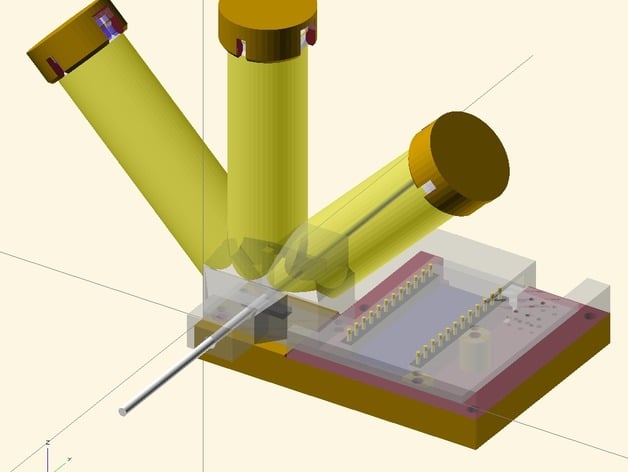
Filament Width Sensor with 3 LEDs, TSL1401CL, and Arduino Pro Micro
thingiverse
Movie: http://youtu.be/TVAAIxcCAu0 This improved sensor thing builds on shadow casting idea by Flipper's #454584 and measures filament width in three directions: -45, 0, and 45 degrees. It does this using sequential LEDs that light up and the sensor measures shadows from each direction. This (hopefully) compensates out-of-round filament shape. Measurement at 45-degree limit maximum measurable filament width around 2.5mm, so this version is only for 1.75mm filament. For 3mm filament, upgrade the line array sensor to wider one such as TSL1402. Update: Download Filament_Widh_Sensor_3LEDs_forUNO.zip for Arduino UNO board. Instructions Download 20150302_Filament_Width_Sensor_3LEDs.zip Prepare PCB and solder components. (tricky and costly part!) Print case/sensorCover.stl in matt black material. ABS was better than PLA in many cases. If the material is not dark enough, paint the black inside the towers. Print three case/led_cap.stl as cover. Mount 5pi LED and cover them with cap. Connect LEDs like the picture. Aware polarity. Upload firmware: Filament_Widh_Sensor_3LEDs.ino. You need to install TimerOne library to Arduino IDE. Refer http://arduino.cc/en/pmwiki.php?n=Guide/Libraries and TimerOne-r11.zip Turn on visualizer (TSL1401_visualizer) in Processing. (http://processing.org). Through the case, put a 2mm rod as reference. Type [0, 1, 2] will select the LED and [j, k] will decrease and increase the LED intensity. Decrease the intensity and slowly increase them until the edge detection algorithm works just fine. The green/red lines indicate the detected edge. 6-1. (UPDATE@Apr 26, 2016) If this step crashes and complains about size() function, replace line 31 with [size(387, 316); ]. Current processing does not allow any variable with size() function. Type [c] to calibrate the sensor. Now you're good to go! If you need more help, type [h] in Serial Monitor@Arduino IDE. Look inside the source files. Any suggestion and additional contribution will always be welcomed. BOM) 1 x Arduino Pro Micro board 1 x PCB 1 x TSL1401 Line scan sensor 1 x 1Kohm resister (SMD 2012) 1 x 10nF ceramic capacitor (SMD 2012) 1 x 0.1uF ceramic capacitor (SMD 2012) 3 x 200ohm resister (SMD 2012) 3 x 10uF multi-layer ceramic capacitor (SMD 2012) 1 x 2x3 pin header 1 x Molex 5046 (right angle, male type mount) 1 x Molex 5051 (female type socket) 3 x High-brightness LED (5mm radius) 8 x 2mm x 8mm sheet metal screw electric wires, pin header sockets, solder, ...
With this file you will be able to print Filament Width Sensor with 3 LEDs, TSL1401CL, and Arduino Pro Micro with your 3D printer. Click on the button and save the file on your computer to work, edit or customize your design. You can also find more 3D designs for printers on Filament Width Sensor with 3 LEDs, TSL1401CL, and Arduino Pro Micro.
